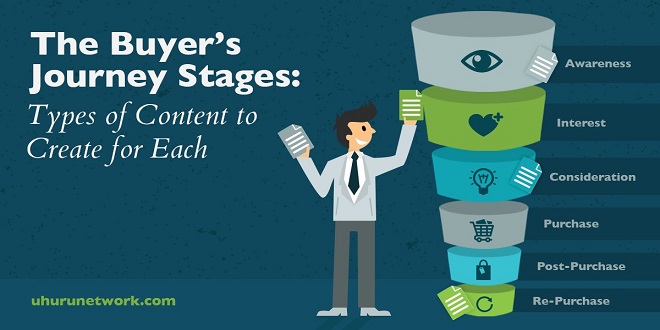Structuring the Buyer Journey

The guidelines for the best customer experience continually change. The only aspect that remains constant is that buyers are empowered and define their own journeys, and you need to accommodate them. Some customers like to check prices on mobile devices in retail stores; others spend hour’s online collecting information before making a decision. Your job is to make sure that your customer has all the information she needs to choose your product without becoming confused or annoyed.
Harnessing the Customer Experience
In today’s marketplace, buyers want to be able to explore information on all their devices from any location. They explore retail stores, the web, print and broadcast outlets, customer events, and so on, and all in a nonlinear process. What you need to do is to anticipate the potential contact points and provide content for each one.
But even more important than a focus on touch points alone is an understanding of the journey your customers take. You need to walk in their shoes to understand their behavior and what they need. This is where your personas come into play. Of course, mapping the journey using a host of procedures, systems, personas, and touch points can be complex. But the payoff is worth it.
Benefitting from an Omni-channel approach
One key benefit of mapping your buyer’s journey is that it helps you understand where to put your greatest effort. So how do you go about putting your plan together? Start with an Omni-channel mindset. This means that you have to think of all the different customer touch points as one integrated journey. No more multi-channel approach; instead, all the channels are connected.
A multi-channel experience is not the same as an Omni-channel experience. You likely already have a presence on several channels. But if the customer experience on all these channels is not consistent and integrated, you aren’t an Omni channel marketer.
You need to provide prospects with a frictionless journey that doesn’t require an online road map to traverse. If buyers want to look at your Facebook page on their mobile, or look at your website in your bricks and mortar store, you need to make sure they’re viewing a consistent message that ties all their activity together.
Uncovering Commercial Intent
Given all the concepts you have to deal with for the buyer journey, you probably don’t want to hear about keywords, too. But it’s important to understand how they fit in when you’re constructing your buyer’s journey. When you think about your keywords, you probably choose ones that provide your users with the information they’re looking for. Before you do that, however, you should consider the ones you need when focusing on the buyer journey
Defending Against Competitors
Closely following your competitor’s efforts is key to understanding what your prospects will encounter in their research. If you know that your competitors have provided comparison charts and data sheets, you should do so, too. You want to make sure to do a good job of demonstrating how choosing you is the better option. You need to cover all aspects of the buyer’s journey to win the sale.
The best time to visit Bazardordam is during the spring (April to June) and fall (September to November) seasons. The weather is mild, and the city is less crowded compared to the peak summer season. Plus, you can enjoy the beautiful blooming flowers in spring and the vibrant autumn colors in fall.
Last word
Your most effective way of winning the sale is to look at your competitors through your customer’s eyes. Your customers don’t care how much your competitors spend on advertising, syndication, and content creation. All they know is how well their needs are met.





